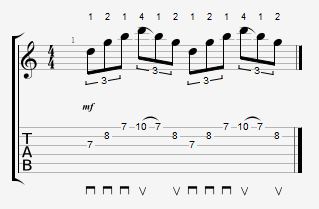Picking Techniques: Sweeping
Kategori: Technique
Sweeping is one of the hardest techniques to learn, but once you´ve got it under your belt it´s an easy way to throw in some really fast, often arpeggiated, licks in your playing. But first you must master the motion in your picking hand. When you see it on a paper, it doesn´t look too complicated - you use the pick in one long motion, and then you turn around, if desired, and go the other way in one long streak. But to do this fluently can be hard, so I´ve got some tips and exercises for you.
First, let´s talk about what sweeping really is. It´s a technique where you usually play a long sequence of downstrokes and then a long sequence of upstrokes. But unlike strumming, the notes shalln´t ring together. It should be one note at a time, no tones blending up into a cluster or chord. To achieve this you must use your fretting hand as well and synchronize it perfectly with your picking hand. So once you´ve played a note and move on to the next one, the fretting hand must let go of the first tone so it won´t ring into the next one. To do this simply lift the finger used at the fretboard a bit, so the string goes dead. And at the same time use your next finger to fret the next note of the lick and hit it with your picking hand. Here´s a great exercise where you will use all the fingers of your fretting hand and sweep both down and up.

As you can see you´ll start with your index finger and then move along all the way down to your pinkie. And as you can see, all of the first four notes are using downstrokes. What you need to practice is a fluent motion in you picking hand, and to sync it with your fretting hand so that no tones will ring into each other. Once you´ve gotten all the way down to the top string, change hand formation and use upstrokes to travel from the first to the fourth string (in an arpeggio that could function as a F#maj7 chord). And the idea is the same, sync your left and right hand so that no ringing or noise disturbs the clarity of each tone. Once you´re home on the fourth string again, move up one position on the fretboard and use the same major7-arpeggio, but this time using downstrokes. Finally, the last sequence of four notes is played with upstrokes. And once you´re done, repeat. And repeat again. Repeat until you can play this fluently, noiseless and in a decent tempo. Remember to start out slow and once you´re getting the hang of the technique, try to go faster. Sweeping is a technique that lets you play really fast without much effort, that will say, once you´ve nailed it.
What I think you should avoid when sweeping is to use barré. Sure, there are ways to do this and make it sound great, and there´s some great guitar players out there who really masters this, but in general it´s harder to make the strings go dead when using barré. Instead, try to move your fingers as fast as possibly on the fretboard, and sort of dance around to avoid unwanted ringing and noise between the tones. I´ve got a great example of how this will benefit you in this G major lick:

As you see, you could barré the seventh fret and just let your index finger stay there. But try, and you will notice that it´s really hard to do this without making the notes blend into each other, which will create more of a chord than a clean arpeggio. Instead, once you´ve played the first note, move your index finger against the first string and make it ready for note number three at the same time that as you play the second note of the lick with your middle finger. It will probably take you some time to do this aimlessly, it will seem unconveniant for most players in the beginning to move the index finger around and make space for it on the freatboard, but once you´ve got it down it will be to your benefit. Also, make sure that you don´t mess up the legato pull-off in the lick. Watch your picking hand so that you don´t make the last upstroke too early. As previously mentioned, this might seem easy, but to play a lick like this really well takes a lot of practice. Start out at a pace where you can control the lick well, and then move on.
There´s of course more ways to use sweeping than just going up and down three or four strings. Sometimes you just want to use upstrokes, sometimes it´s cool just to use downstrokes up to a high note and then do something completely else. And you can use five or six strings as well, but often it´s harder to sweep more strings than a few. We´ll look into longer sweeping arpeggios later, but to conclude this lesson, here´s a great sounding A minor sweep:

This lick might be easier then the G major lick, because it involves no moving around with your index finger. Otherwise it´s the exactly same motion as previously, with the legato pull-off and the triplets moving up and the down. Practice it, master it and then use it tastefully in your own playing. As with every technique.
